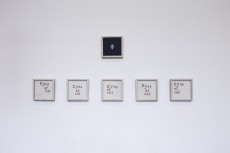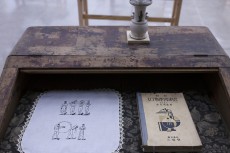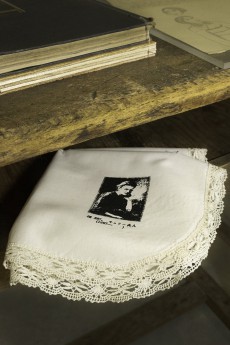
The Beginning of Life/Art: Cloth Weaves Our Times, from Aomori
May 7 (Thu)- August 30 (Sun), 2020
USUI Yui

study of landscape, 2020 Photo: Delphine Parodi
The artist USUI Yui considers her personal experiences and questions that are triggered by events and histories, which people pretend not to see in the present society, as something social and political. Through researching about those events and histories, she gains her own understanding of them and expresses this as artworks by using techniques familiar to her, such as handcraft. Upon visiting Aomori, she took particular note on Tsugaru Kogin-zashi and science textbooks, which were used in the girls’ schools before the Second World War.
In Kogin-zashi, in which patterns are created through making stitches on the odd numbered rows on cloth, there are about forty kinds of standard, geometric patterns called ‘Modoko’. Usui has interpreted Kogin, which is a series of representations of animals and plants living in this land, as landscape paintings of Aomori. Originally, Kogin was made with a practical purpose of filling coarse textures of hemp kimonos and making them warmer. However, it has become an enjoyable embroidery hobby in present times and the old Kogin patterns are continuously being imitated. In the Western embroidery techniques, there is a technique called Cross-stitch, in which patterns are created on the grid by stitching threads in crosses. Samplers used as stitching examples were the collection of all the fruits of stitching techniques women had learned since their childhood. For this occasion, Usui held a workshop titled ‘Embroidery Cafe’, and, together with local people and students, they stitched the pattern names of Modoko in English, using the Cross-stitch technique. In spite of every participant supposedly having approached the task in the same way, just like in a school lesson, what they made varied in details or in the positions where they started stitching. The workshop gave us a chance to ponder how each of us is looking at our surrounding world.
As a part of the archived collection of craft objects used among ordinary people, the artist found science textbooks (physics, chemistry, flora and fauna, and physiology and hygiene) with the written marks on their covers saying, ‘for girls’. In the times before the war, the roles to be fulfilled by women were thought to be mainly the domestic tasks. Those textbooks, which were specifically edited to be used among girls, cover natural-scientific phenomena and topics, which related closely to people’s living back then. Usui selected illustrations from the textbooks, sorted them into categories, and printed them on pieces of cloth, which are displayed on the table in the exhibition.
Japan went through the rapid modernization by the westernization of initiatively taking in cultures and products from the West. It was the time when the approach to learning changed: from learning through directly being in contact with nature in the life of rural villages and experiencing phenomena that happen in the real world to learning through systematically understanding principles, which are put together by someone, mentally. For us, who are going about our life in the latter way, we have access to a wide range of information, however at the same time, we might unconsciously internalize other people’s views and opinions on how things should be. Usui’s work in this exhibition poses a question to us: how have the landscapes we are seeing now been formed by imitating/learning?
Text: KEINO Yuka, Translation: NAGASAKA Aki
・Illustrations Cited (Owned by Aomori City Board of Education)
SHIBATA Yuji, “Revised Edition: Latest Chemistry Textbook for Girl’s Curriculum”, Fuzambo, Tokyo (1929)
KUWAKI Ayao, “New Revision: Physics Textbook for Girls”, Sanseido, Tokyo (1930)
・Reference of ‘Modoko’
koginbank https://koginbank.com/

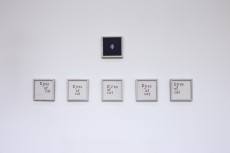
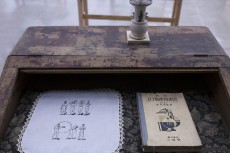

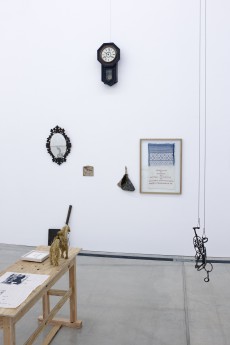

いのちの裂け目ー布が描き出す近代、青森から
2020年5月7日(木)~8月30日(日)
碓井ゆい
USUI Yui

≪景色をならう≫2020年
撮影:デルフィン・パロディ
現代社会において見てみぬ振りをされている出来事や歴史について、個人的な経験や疑問を社会的・政治的なものとして捉え、リサーチを通して紐解き、手芸などの身近なテクニックを用いて作品制作をしているアーティストの碓井ゆい。彼女は青森を訪れ、津軽こぎん刺しと戦前の女学校で使われていた理科教科書に着目しました。
布の奇数目を刺して柄を描いてゆくこぎん刺しには「もどこ」と呼ばれる、幾何学的な基礎模様が約40種類あります。この地の動植物を模ったものの連なりであるこぎんを、碓井は青森の風景画と捉えました。元々こぎんには、麻の着物の目を詰め強くし防寒するという実用性がありましたが、現在では趣味の刺繍として愛好され、古作こぎんの柄は倣われ続けています。西洋刺繍にも、糸をクロスさせて刺すことで図案をマス目上に作ってゆくクロスステッチの技法があります。刺し方の手本となるサンプラーは、女性が幼少期から学んだ刺繍技術の成果を集約したものでもありました。今回「刺繍カフェ」と題したワークショップを開催し、市民や学生のみなさんと、もどこの名称の英訳をクロスステッチで刺してみました。学校の授業のように、みな同じように取り組んだはずですが、細かく見ていくと所々違っていたり、刺し始める位置が様々だったり。人はそれぞれ、どのように世界を見つめているのでしょうか。
民俗資料の一部に、女子用と書かれた理科(物理、化学、動植物、生理衛生)教科書がありました。女性の果たすべき役割が、主に家庭内にあると考えられていた戦前期。女子向けに編集された教科書には、暮らしに身近な自然科学として各現象や項目が扱われています。教科書から取り出された図版は、それぞれのカテゴリーに分け、机上の布にプリントし直されました。
西洋の文物を積極的に取り入れる文明開化によって、急速な近代化をとげた日本。農村の営みのなかで自然と直に触れ合い、この世界に起こる現象を体得してゆくよりも、誰かがまとめた原理を体系的に頭で理解することが学びとなっていった時代。多くの知識を得られる一方で、他者のものの見方やかくあるべきとされることが無意識にも内面化されているのかもしれません。私たちが見ている風景は、ならうことによってどう形作られてきたのでしょうか。
テキスト:慶野結香
◎図版引用(青森市教育委員会所蔵)
柴田雄次『改訂 女子教科最新化学教科書』冨山房、昭和4(1929)年
桑木或雄『新訂 女子物理学教科書』三省堂、昭和5(1930)年
◎もどこ参考
koginbank https://koginbank.com/
